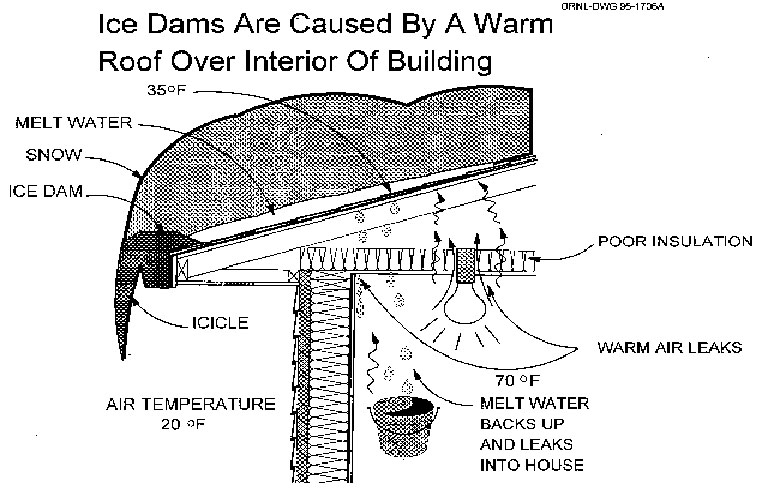Ice dams may be hidden under the snow on sloped roofs with inadequate insulation. Two circumstances combine to make an ice dam. First, snow melts on the part of the roof over the building interior (inside the perimeter of the outside walls) because heat and air that leak from the warm interior raise the roof temperature above the freezing temperature. Second, on the part of the roof covering the overhang (beyond the perimeter of the outside walls), the roof is cold and the runoff refreezes. The refrozen runoff forms a dam, further backing up melt water.
Backed up water can get under the shingles and through the roof deck. It can drip on the ceiling insulation or run down the underside of the deck to the connection between the roof and the walls. It then makes its way into the building in the form of damaging leaks. Melt water under the unmelted snow can decrease the friction between the snow and the roof and cause a snow slide, like an avalanche. Melt water often refreezes as icicles hanging from the gutters or edge of the roof. These icicles eventually break off when they get too heavy. Both snow slides and falling icicles endanger passersby.
Energy Efficient Roofs are Less Like to Have Ice Dams
Energy efficient roofs minimize problems with ice dams because they keep the entire roof cold. There is little difference in temperature between the part of the roof inside the perimeter of the outside walls and the part covering the overhangs. Thus, melting and refreezing is minimized.
Insulating to prevent heat leaks and sealing against air leaks between the inside of the building and the attic are the best ways to achieve a cold roof.
Increasing the level of insulation from R-11 to R-38 in a 1000 square foot attic usually cost 50% less than accumulated dollar savings for heating and cooling, beyond the cost of the installed insulation and 10 times less than costs to repair damage from a leak caused by an ice dam. Ventilation of the attic may help to achieve a cold roof. Its primary purpose, though, is to prevent moisture from condensing in the attic on the underside of the roof and dripping down into the insulation. This moisture is in any warm air that leaks from the inside of the building. Sealing the air leaks is more effective than increasing the ventilation.
To stop dammed up water from leaking under the shingles use a waterproof membrane under the parts of the roof where ice dams occur and melt water backs up. The membrane is usually placed from the edge of the roof up beyond where the walls intersect the roof. This membrane is installed when old shingles are replaced. If ice damming is a recurrent problem, heaters along the edge of the roof can be used to break up ice dams as they form. But these heaters use a lot of expensive electrical energy; they need to be used whenever it snows until air temperatures are about 45º F.
If ice dams are building up and no heaters are in place, building owners may want to take emergency action. Hammers, hatchets, ice picks or even salt used at the edge of a roof to attack ice dams and icicles do more harm than good and are not recommended. If snow is piling up to the point where the roof seems or sounds vulnerable to collapse, some snow can be removed but safety is the first concern. The object of snow removal from roofs is to reduce the snow load to safe levels, not to clean it off entirely. Regardless, there is danger of damage to the roof surface from using implements such as rakes or shovels. There are hazards to people who climb up to the roof on slippery ladders and stand on them. Walking on an already stressed roof may cause local failures in the structure. Snow removal from a roof is a risky proposition. Use a licensed contractor in most cases.

Ice dams are caused by a warm roof over interior of building.
A well-designed, energy efficient roof should tolerate the loads of once every 50 year events like the recent snowstorms in the northeastern U.S. Nature eventually melts snow from roofs more cheaply and safely than artificial means. Best to let nature take its course and observe deficiencies in a particular roof, such as lack of insulation and unwanted air leakage paths from the interior space to the roof, so corrections can be made before the next emergency.
The U.S. Department of Energy, through its Buildings Technology Center at the Oak Ridge National Laboratory in Tennessee, is working to provide builders, contractors and owners of buildings with research results to facilitate cost effective, energy efficient roofs and/or attics in every building. Much of the relevant information is collected in an upcoming Attic Handbook. Energy information is available from the Energy Efficiency and Renewable Energy Clearinghouse.
The information presented here was prepared by the Buildings Technology Center and has focused on ice dams, how to eliminate their cause, and what to do and not do about ones that appear as a result of the blizzard of '96 and future snowstorms. This information is summarized from the Attic Handbook and from results of research at the U.S. Army Corps of Engineers' Cold Regions Research and Engineering Laboratory as well as in the Division of Building Research of the National Research Council of Canada.









